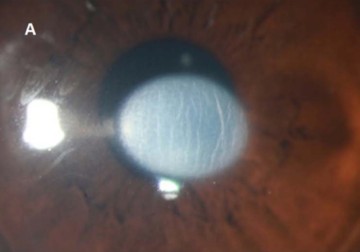In a recent study from LVPEI, Drs. Pravin K. Vaddavalli, Pankaj Dongre, Akhil Bevara, and Rashmi Deshmukh present a case series of central toxic keratopathy, a non-inflammatory complication, after collagen cross-linking treatment in patients with keratoconus.
Patients with keratoconus have an unstable cornea, the transparent and fibrous outer tissue of the eye, which thins and distends over time. Loss of corneal stability in keratoconus can cause vision loss. Collagen cross-linking (CXL) is a technique that is performed to strengthen the cornea in patients with keratoconus. CXL uses vitamin B12 (riboflavin) as a photosensitizer to catalyze and activate UV-A mediated covalent bond formation within and between corneal collagen fibers. The procedure strengthens and stabilizes the cornea, arresting distention. Like any surgical procedure, CXL has a small risk of complications.
Central toxic keratopathy (CTK) is a rare, acute, noninflammatory complication characterized by longitudinal furrows in the cornea. CTK can be observed after surgical removal of corneal layers, such as in LASIK, photorefractive keratectomy (PRK), and phototherapeutic keratectomy (PTK). While CTK’s association with photorefractive surgery is established, there has been no evidence of the complication arising due to CXL. Only a single case of CTK has been reported till now where the patient underwent PRK—often used to improve visual acuity in keratoconus patients—after CXL.
Now, in a new study published in the journal Cornea, Drs Pravin K. Vaddavalli, Pankaj Dongre, Akhil Bevara, and Rashmi Deshmukh report a case series of CTK after CXL treatment in patients with keratoconus—the first such report. The study draws from a sample of 964 keratoconus patients (aged 16-32 years) who underwent CXL at LVPEI, between January 2020 and September 2021. Among them, 12 patients (1.2%; 6 men and 6 women) developed CTK within a week of CXL surgery.
Patients with CTK showed increased opacity (hazing) limited to the central cornea. The affected area flattened and recovered without intervention over 3-12 months, though not to pre-operative levels. The haze also gradually dissipated over 12 months. The cornea of patients with CTK was thinner than those who did not develop CTK after CXL. The case notes an association between the haze, the depth of the CXL, and keratocyte loss. CTK after CXL remains a rare and self-limiting condition, and its characteristic haze is different from other kinds of corneal haze.
‘The study helps differentiate central toxic keratopathy from other conditions such as post collagen cross-linking haze, or collagen cross-linking scar,’ remarks Dr. Pankaj Dongre, Consultant Ophthalmologist at LVPEI and the first author of this paper. ‘This helps improve the management of post-CXL complications and will help in preventing unnecessary treatment of the patients.’
Citation
Dongre P, Bevara A, Deshmukh R, Vaddavalli PK. Central Toxic Keratopathy After Collagen Cross-Linking: A Case Series. Cornea. Published online November 28, 2023.



